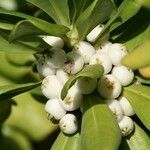Shrub or small tree, 2–3(–4) m. tall.. Stem glabrous, fleshy, bearing persistent leaf-scars.. Leaf-axils (and bract-axils) with prominent tufts of white silky hairs; leaves sessile, spathulate or obovate to narrowly obovate, 6–25 cm. long, 3–10 cm. broad, entire or distally faintly crenate, obtuse, narrowed gradually below the middle, abruptly broader at the base which partially clasps the stem, glabrous, thinly fleshy, light green with a tendency to turn blue when dried; lateral veins faint, all widely diverging, up to 25 pairs.. Inflorescences axillary, cymose, 5–10 cm. long, 1–13-flowered, overtopped by the leaves, with many paired pubescent bracts 2–3 mm. long.. Calyx-tube turbinate; teeth 3–6 mm. long, erect, persisting and sometimes lengthening on the fruit.. Corolla blue to white, sometimes with mauve markings; tube 8–17 mm. long, 3 mm. broad; lobes elliptical, 8–13 mm. long, 4–5 mm. broad, the central portion thicker than the crenulate marginal zone.. Ovary 2-locular; style simple.. Fruit whitish, subglobose, 8–15 mm. long, slightly constricted medially, faintly 10-ribbed, 2-seeded. The corky fruits float in sea water and remain viable after prolonged immersion.. Fig. 1/1–9.
Arbuste souvent buissonnant, pouvant atteindre 3-4 m de hauteur, généralement glabre, sauf aux aisselles des feuilles. Feuilles plus ou moins charnues, sessiles, spatulées-obovées, grossièrement dentées vers l’extrémité, plutôt groupées vers le sommet des rameaux, longues de 6-10 cm en moyenne et larges de 3-5 cm, mais pouvant atteindre 18-20 x 7-8 cm; aisselles garnies de soies blanches tardivement caduques. Fleurs en cymes bipares régulières, 3-4 fois ramifiées, longues de 2-5 cm; lobes du calice linéaires-triangulaires, longues de 2-5 mm ou ovées; corolles jaune très pâle ou blanche, veinée de mauve pâle, longue de 2-2.5 cm, glabre à l’extérieur, densément pubescente à l’intérieur du tube; lobes longs de 4-5 mm; style faiblement pubescent à la base; ovaire infère. Fruit drupacé de 1-1.5 cm de diamètre, légèrement côtelé sur le frais, fortement sur le sec, blanc-nacré à maturité; noyau long de 6-8 mm, rugueux, contenant 2 graines. Fl., fr. toute l’annee.


